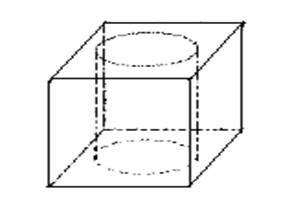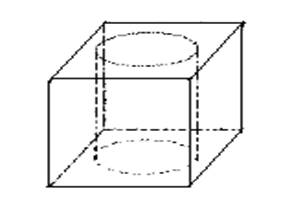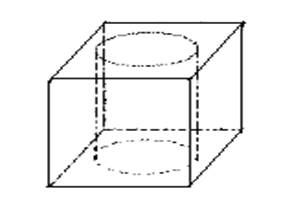
Concept explainers
a.
To calculate: The volume of ice in each cube.
a.
Answer to Problem 20PSC
The volume of ice in each cube is
Explanation of Solution
Given information:
An ice cube manufacturer makes ice cubes with holes in them. Each cube is 4 cm on a side and hole is 2 cm in diameter.
Formula used:
Volume of cube
Where s = side of cube
Volume of hole
r = radius of hole,
h = height of hole.
Calculation:

Volume of cube
Each cube is 4 cm.
Volume of cube
Volume of cube
Volume of hole
Volume of hole
Volume of hole
Volume of hole
Volume of ice = Volume of cube − Volume of hole
Volume of ice
Volume of ice
b.
To find: The volume of water left when 10 cubes will melt.
b.
Answer to Problem 20PSC
The volume of water left is
Explanation of Solution
Given information:
An ice cube manufacturer makes ice cubes with holes in them. Each cube is 4 cm on a side and hole is 2 cm in diameter.
Water volume decreases by
Formula used:
Volume of cube
Where s = side of cube Volume of hole
r = radius of hole,
h = height of hole.
Calculation:

Volume of cube
Each cube is 4 cm.
Volume of cube
Volume of cube
Volume of hole
Volume of hole
Volume of hole
Volume of hole
Volume of ice = Volume of cube − Volume of hole
Volume of ice
Volume of ice
Volume of 10 cubes
Water volume decreases by
Volume of 10 melted cubes
Volume of 10 melted cubes
c.
To calculate: The total surface area of a single cube.
c.
Answer to Problem 20PSC
The total surface area of a single cube is
Explanation of Solution
Given information:
An ice cube manufacturer makes ice cubes with holes in them. Each cube is 4 cm on a side and hole is 2 cm in diameter.
Formula used:
Facial area of the cube
where s = side of cube.
Base area of cylinder
where r = radius of cylinder
Lateral area of cylinder
where
r = radius of cylinder
h = height of cylinder.
Calculation:

Facial area of the cube
Facial area of the cube
Facial area of the cube
Base area of cylinder
Base area of cylinder
Base area of cylinder
Lateral area of cylinder
Lateral area of cylinder
Lateral area of cylinder
Total Area = 6(Facial area of the cube) − 2(Base area of cylinder) + Lateral area of cylinder
Total Area
Total Area
Total Area
d.
To verify: The total surface area of a cube is twice the total surface area of cube without holes.
d.
Explanation of Solution
Given information:
An ice cube manufacturer makes ice cubes with holes in them. Each cube is 4 cm on a side and hole is 2 cm in diameter.
The manufacture claims that these cube cool a drink twice as fast regular cubes of the same size.
Formula used:
Facial area of the cube
where s = side of cube.
Base area of cylinder
where r = radius of cylinder
Lateral area of cylinder
where
r = radius of cylinder
h = height of cylinder.
Proof:

Facial area of the cube
Facial area of the cube
Facial area of the cube
Base area of cylinder
Base area of cylinder
Base area of cylinder
Lateral area of cylinder
Lateral area of cylinder
Lateral area of cylinder
Total Area = 6(Facial area of the cube) − 2(Base area of cylinder) + Lateral area of cylinder
Total Area
Total Area
Total Area
Total area of a cube without hole
Total area of a cube without hole
Total area of a cube without hole
The ratio of area is as follows.
The manufacturer claim is not true because the ratio is not two.
Chapter 12 Solutions
Geometry For Enjoyment And Challenge
Additional Math Textbook Solutions
Finite Mathematics for Business, Economics, Life Sciences and Social Sciences
Algebra and Trigonometry
Elementary and Intermediate Algebra: Concepts and Applications (7th Edition)
Linear Algebra with Applications (9th Edition) (Featured Titles for Linear Algebra (Introductory))
An Introduction to Mathematical Statistics and Its Applications (6th Edition)
 Elementary Geometry For College Students, 7eGeometryISBN:9781337614085Author:Alexander, Daniel C.; Koeberlein, Geralyn M.Publisher:Cengage,
Elementary Geometry For College Students, 7eGeometryISBN:9781337614085Author:Alexander, Daniel C.; Koeberlein, Geralyn M.Publisher:Cengage, Elementary Geometry for College StudentsGeometryISBN:9781285195698Author:Daniel C. Alexander, Geralyn M. KoeberleinPublisher:Cengage Learning
Elementary Geometry for College StudentsGeometryISBN:9781285195698Author:Daniel C. Alexander, Geralyn M. KoeberleinPublisher:Cengage Learning

